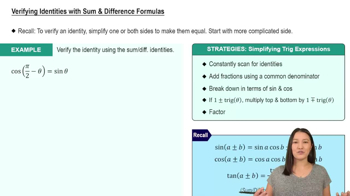For each expression in Column I, use an identity to choose an expression from Column II with the same value. Choices may be used once, more than once, or not at all.
sin 35°
 Verified step by step guidance
Verified step by step guidance



For each expression in Column I, use an identity to choose an expression from Column II with the same value. Choices may be used once, more than once, or not at all.
sin 35°
The half-angle identity
tan A/2 = ± √[(1 - cosA)/(1 + cos A)]
can be used to find tan 22.5° = √(3 - 2√2), and the half-angle identity
tan A/2 = sin A/(1 + cos A)
can be used to find tan 22.5° = √2 - 1. Show that these answers are the same, without using a calculator. (Hint: If a > 0 and b > 0 and a² = b², then a = b.)
Find the exact value of each expression. (Do not use a calculator.)
cos (7π/9) cos (2π/9) - sin (7π/9) sin (2π/9)
Perform each indicated operation and simplify the result so that there are no quotients.
(tan x + cot x)²
For each expression in Column I, use an identity to choose an expression from Column II with the same value. Choices may be used once, more than once, or not at all.
-sin 35°
For each expression in Column I, choose the expression from Column II that completes an identity.
2. csc x = ____